Recently, Graham Taylor – an experimental archaeologist based in Northumberland – put together his own clay version of the central Mithraic image (the ‘tauroctony’). He’s done an incredible job of it too:
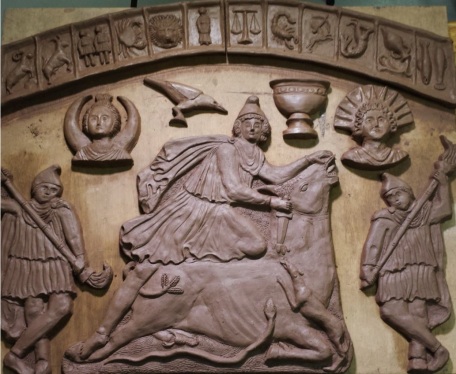
Unsurprisingly, I’ve seen quite a few tauroctonies in my time, from Rome to the Danube to Hadrian’s Wall, and inspired by Graham’s work I thought I’d give a quick a rundown of some of my favourites. See, while the tauroctony has set elements it has to include and present in certain ways, like any art there’s a degree of individuality in each version. Different people can see the same image in various lights and take certain things from it. Either that or some artisans are more crappy than others, but, whatever, they still have their charm.
Before launching into my list, I should probably explain what the tauroctony actually is. This was the main image of the cult of Mithras, present (we assume) in every mithraeum, a bit like Christ on the cross in churches. Usually it was placed at the end of the main aisle on a raised platform or in a niche, making it the focus of the room. At its centre it depicts Mithras slaying a bull inside a cave. This scene is usually flanked by the two torchbearers (Cautes and Cautopates) in the lower corners, while Sol (the Sun) and Luna (the Moon) appear in the upper corners on the left and right respectively. Around the bull is often found a dog and snake, who are feasting on the blood of the bull, while a scorpion pinches the bull’s bullocks (who said ancient religions aren’t fun?). A raven often appears above the head of Mithras, while occasionally a krater (basically a large ceramic vase) and a lion sometimes show up too.
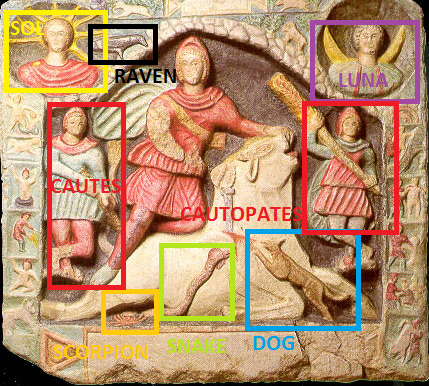
All of these aspects of the image were symbolic, although without any written accounts from the cult what they symbolise is open to interpretation. Generally, it’s agreed that Mithras slaying the bull was supposed to signify creation or rebirth, with the animals feeding on the life blood (or seed in the case of the scorpion) of the bull – it dies so that they may live. Sometimes, the bull is shown with grape-vines or corn-ears emerging from its wound or tail.
That Mithras is equated with Sol and the bull was a symbol of the Moon (and is often depicted with its body in a crescent shape) may also mean it represented the victory of light over darkness. The raven is thought to have been the messenger of Sol, passing the order onto Mithras to enact the deed, which is why it is usually positioned between the two of them. The cave was probably a symbolised the universe, because like the universe a cave only has an inside and not an outside. The torchbearers are the personifications of the rising (Cautes with his raised torch) and setting (Cautopates with his lowered torch) sun. Simples, right?
Given that the seven Roman planets were important in the Mithras cult (but that’s a discussion for another time), here’s seven of my favourite Mithraic reliefs:
1.London (mid-late 3rd c.)
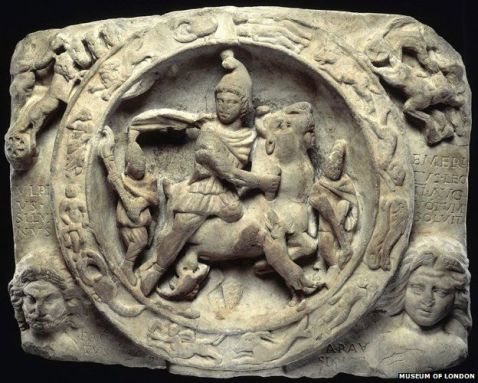
As a London boy I’ve got to represent, right? This wouldn’t have been the central relief of the London Mithraeum as it’s too small (only fragments of the central sculpture have survived), but it’s still a great little number. The main scene is encircled by the signs of the zodiac, which I think in this case signifies the cave/universe. Neat little additions are Sol and Luna shown riding their chariots, the former being led by horses and the latter by oxen. It was paid for by Ulpius Silvanus, an ex-soldier who came from Gaul (modern France).
2. San Stefano Rotondo, Rome (late 3rd c.)
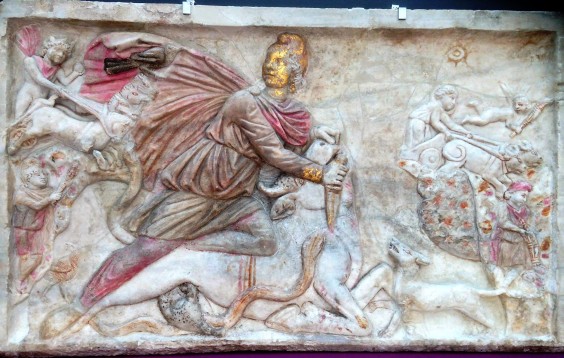
I love this one mainly because it’s one of the few examples we have where the colour has survived. Most people tend to think of Roman reliefs and statues as plain and grey, but in reality they would have been covered in bright paint and gilding. In this case, we can see Mithras would have worn a bright red tunic and had a face of gold. Notable unusual additions to this relief are a cockerel next to Cautes and an owl at the feet of Cautopates, emphasising their status as dawn and dusk, while Hesperos (the evening star) is shown as a cherub-like figure next to Luna.
3. Mithraeum III(?), Carnuntum, Austria (3rd c.)
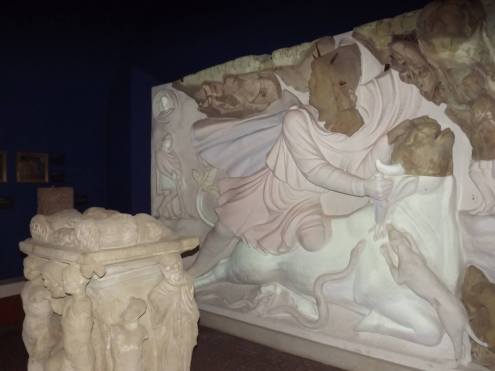
I’m including this one because it’s ridiculously MASSIVE (2.75m x 3.88m). Only parts of it survive: Mithras’ head, part of the bull’s head, Luna, and the dedicatory inscription by Titus Flavius Viator , but these give an indication of how large it was. Usually, Mithraic reliefs are relatively small(ish) because mithraea were confined spaces into which only so many people could fit. In contrast, this behemoth of a relief could be seen from far way, suggesting a very large gathering came together to worship it. We don’t actually know which mithraeum in the town (there are two confirmed and another possible two) it came from, but one of them is among the largest examples ever found in the Roman World, making it the most likely contender.
4. Aquileia, Italy (2nd c.?)
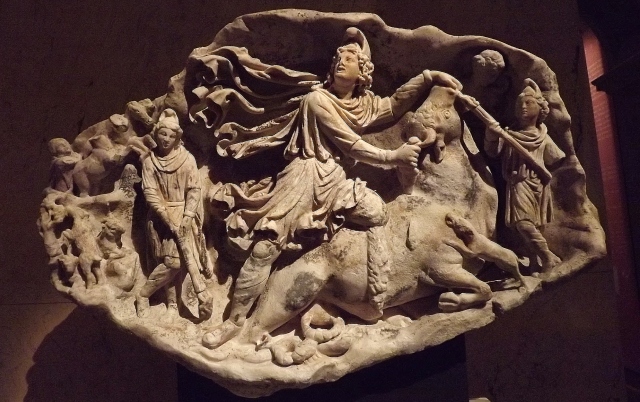
I don’t have much to say about this representation expect ‘damn son, just look at’. Cut from marble, it really is a work of art. If I ever get something like this out of the ground while excavating, I’d probably keel over and die a happy man right there.
5. St. Andrä, Austria (2nd c. ?)
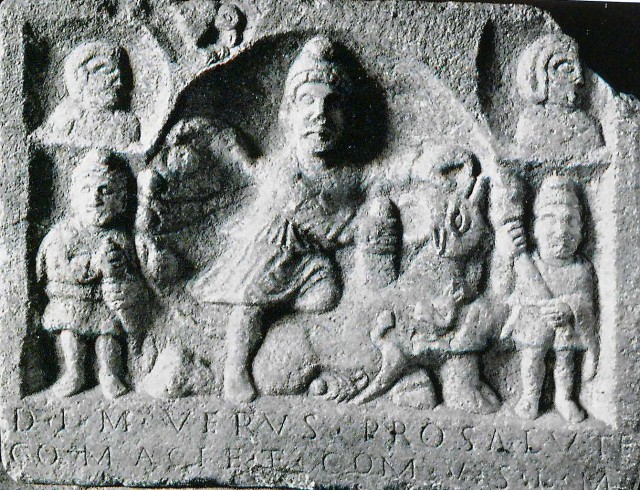
This one is great to follow on from Aquileia with because it’s so weird in its execution. The faces of the characters are all so uniform, with Sol and Luna only identifiable by their positions. Furthermore, Mithras stares straight out at you in this relief, rather than facing away from the bull as he usually does. Is it bad art or just a regional interpretation? We don’t know, and I suppose it depends on your own perspective whether its ‘bad’ or ‘unique’ (beauty is in the eye of the beholder, afterall), but I quite like it for its quirkiness. It was dedicated by soldier named Verus.
6. Sarrebourg, France (late 3rd c.)
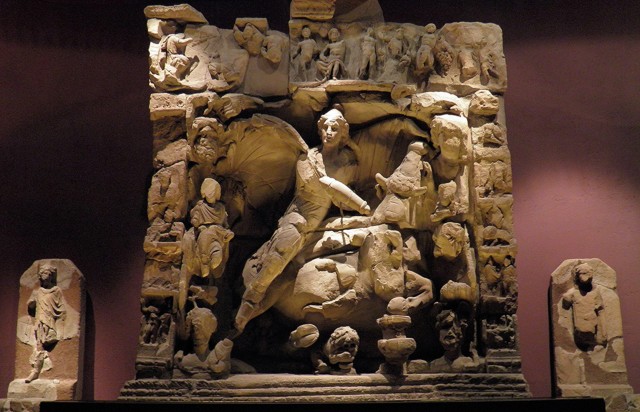
This sandstone relief is kind of a mix of the aforementioned examples found at Carnuntum and Aquileia. It’s pretty big (2.6m x 2.2m), but the craftsmanship is also incredible. A lot of the image has been destroyed, including Mithras’ head (originally his face would probably have been tilted away from the bull more, unlike in the restoration) but enough survives to make you utter words that can’t be repeated in a blog-post. It contains a lot of extra stuff compared to the other reliefs I’ve listed: the lion and krater appear under the bull, while the four wind gods (Boreas, Eurus, Notus and Zephyrus) are carved into the four corners of the scene. Around the main images is a border which contains depictions of episodes from the life of Mithras: being born out of a rock, various meetings with Sol, wrestling with the bull, and Jupiter sat on this throne. This tauroctony also came with two smaller, separate reliefs of the torchbearers. All three were dedicated by the same man, Marcellus Marianus.
7. Rome (date unknown)
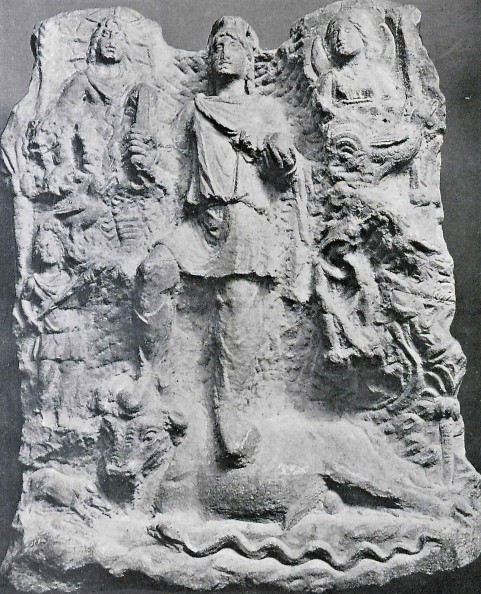
Strictly speaking this one isn’t a bull-killing scene, rather it shows Mithras post-sacrifice standing over the fallen bull with a globe in his hand. Mithras is often referred to as Invicto, which means ‘unconquered’, and this relief really does a good job of presenting him in this way. Where it comes from is unclear, but its been in Rome for a few hundred years at least.
So now I’ve whet your appetite for Mithraic iconography and probably made you think twice about ordering steak again, I suppose you’re wondering what’s to become of Graham’s replica? Well, it’s somewhat fitting that, for an image in Roman times would have sat in a dark, smelly room, Graham’s representation is going on the wall of a Wetherspoons in Chester. Especially on chicken-club nights (extreme niche joke).